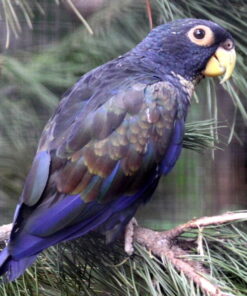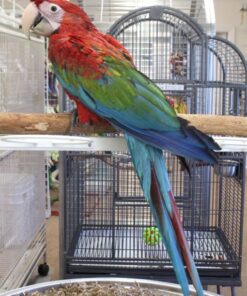Catalina Macaw Parrots For Sale
$850.00
Catalina Macaw Parrots For Sale
Description
Catalina Macaw (Rainbow Macaw): Bird Species
These Catalina macaw is a rainbow-colored hybrid parrot that is desired for the traits it shares with its parents—two of the most popular macaw species. Its flashy colors make it highly attractive for prospective parrot owners. However, it is often its comical personality, intelligence, and the ability to respond to training that seals the deal.
Species Overview
COMMON NAMES: Catalina macaw parrot, rainbow macaw
SCIENTIFIC NAME: HybridAra ararauna x Ara macao
ADULT SIZE: 35 inches, weighing 2 to 3 pounds
LIFE EXPECTANCY: 50 to 60 years
Origin and History
This breed was formed by crossing blue and gold macaw with scarlet macaw. Catalina macaws are found mainly in captivity. You seldom find a naturally bred Catalina macaw in the wild.
In bird breeding and hybridization, the father’s genes are most often dominant. Catalina macaws most often look like scarlet macaws, since the male is usually a scarlet.
These Catalina macaw is considered a first-generation macaw hybrid. It was derived from two naturally occurring or “true” birds. Since this is such a beautiful bird, some breeders use it for breeding a number of second-generation hybrid macaws (those from at least one hybrid bird). It is also rather common to find second-generation Catalinas that are a cross between two Catalina parents.
Catalina macaw has contributed its genes to many colorful macaw hybrids
Temperament
Owners of hybrid macaws get the best of both worlds from their parent species. Scarlet macaws are known to be curious, feisty, and extremely active. In contrast, blue and gold macaws have a reputation for being more laid-back and gentle; they’re also great talkers. Those with Catalina macaws describe their birds as being a perfect mix between the two.
Every bird—no matter the species—will have a unique personality that will reflect its upbringing. Catalinas can be cranky with very demanding social needs or extremely affectionate and charming with fun times ahead for its adopted family. Some Catalina macaws will become one-person birds. They may even prefer men or women exclusively, shunning people of the opposite sex.
The bird is likely to be social and accepting of people if it is introduced to a variety of people when you first bring it home. This species can make a good family pet as long as the children are not too young. Teach the bird and the children to respect one another from the start.
Highly intelligent, Catalina macaws respond well to training and can be taught to perform several tricks and to talk.
Speech and Vocalizations
Many Catalina macaws can attain a vocabulary of around 15 words and phrases over their lifetime. They can get loud and scream when excited, agitated, bored, or just to let you know the sun is up. This pet is not likely a suitable candidate if you have close neighbors, such as in an apartment building.
Catalina Macaw Parrot Colors and Markings
Generally, hybrid macaws are bred primarily for their color traits. The Catalina macaw has a wide range of colors and patterns. There are slight differences from one generation to the next as well.
Most of these birds are primarily red or deep orange on their chests and bellies. Some have brilliant red-orange heads while others have a gorgeous blue-green crown. They tend to have green and blue feathers running down their backs and long tails. Many of them have gold feathers edging their wings and their tails.
Catalina looks similar to the harlequin macaw. The two hybrids are often mistaken for one another. The most significant difference is the Catalina usually has the long, tapering tail of the scarlet.
There is no noticeable difference between male and female Catalina macaws. To tell them apart, you will need a DNA test, chromosomal test, or surgical sexing procedure. The DNA test is the most noninvasive option.
Caring for the Catalina Macaw Parrot
Being social birds, they must spend adequate time bonding with their owners to become happy, well-adjusted pets. If you are looking to adopt a Catalina macaw, make sure that you have at least 2 to 4 hours to spend with your bird every day. These parrots thrive on interaction and will become depressed and destructive if neglected or ignored.
With all large parrots, these birds need a large cage that is no less than 4 feet wide and long by 5 feet high. The more space you can provide, the better off your bird will be. Give the bird plenty of perches and toys to keep it engaged.
Potential owners should think seriously about macaw ownership. Are you willing to be awakened early every morning by a screaming parrot? Can you accommodate the several hours of socialization and exercise every day? Also, consider the costs of owning a pet macaw. Veterinary bills, high-quality feed, toys, and cages all add up. If you can’t provide your bird with the best of everything, think about waiting to adopt one until you can. The more that you spoil a parrot, the better your pet ownership experience will be.
Common Health Problems For The Catalina Macaw Parrot
The health care concerns for Catalina macaws are the same as other macaw species. Some of the more common illnesses seen in macaws include:
- Proventricular dilation disease (an intestinal problem, also called wasting disease)
- Psittacosis (a bacterial infection, also called chlamydiosis or parrot fever)
- Other bacterial, viral, or fungal diseases
- Allergies
- Beak malformations in chicks
Birds that are bored, have a poor diet, want a mating partner, or need a bath might resort to feather picking or plucking. Remedy this self-mutilating behavior by addressing their needs immediately.
Diet and Nutrition For The Catalina Macaw Parrot
macaws eat a variety of seeds, plants, fruits, and nuts. Like any large parrot, feed a Catalina macaw a diet that includes a high-quality seed and pellet mix, along with fresh bird-safe fruits and vegetables. Each macaw, depending on its size, will eat about 1/2 to 3/4 cup of parrot mix and about 1/2 to 3/4 cup of fruit and vegetables every day. You can feed it once in the morning upon waking and at dusk before it goes to sleep.
Fruits that are good to feed to macaws include apples, pears, plums, cherries, grapes, oranges, bananas, mangos, papayas, and berries. Healthy vegetables include carrots, sweet potatoes, cucumbers, zucchini, and leafy greens. Never feed avocado; it is toxic to birds. As a treat, offer nuts like macadamias, walnuts, pecans, almonds, and filberts. (We have the special Catalina Macaw Parrots For Sale as listed).
Catalina Macaw Parrots For Sale
Catalina Macaw Parrots For Sale Online
Catalina Macaw Parrots For Sale Near Me
Cheap Catalina Macaw Parrots For Sale
Cheap Catalina Macaw Parrots For Sale Online
They are well raised and socialized.
They come with;
*DNA test
*CITES certificate
*Current veterinary certificate
*Health certificate
*Hatching Certificate
*Care Sheet/Fact Sheet
*Diet Sheet
Banded: Yes
Talking Ability : Yes Confirmed 100% Guaranteed
Age : 1 Year
DNA Sex: Males & Females
Our shipping is 100% guaranteed worldwide and delivery directly to client address.








⚖ You have a message(-s) # 597. Go > https://telegra.ph/Go-to-your-personal-cabinet-08-25?hs=f37809006f2acb28e89c32e6cc4a8a23& ⚖ –
8jom6z